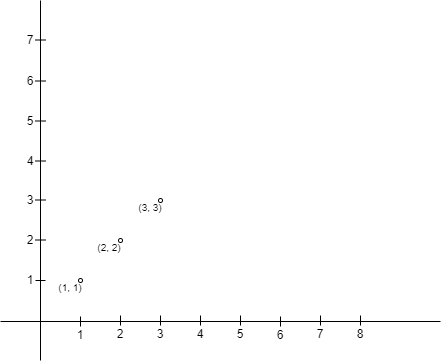3025. Find the Number of Ways to Place People I
Description
You are given a 2D array points of size n x 2 representing integer coordinates of some points on a 2D plane, where points[i] = [xi, yi].
Count the number of pairs of points (A, B), where
Ais on the upper left side ofB, and- there are no other points in the rectangle (or line) they make (including the border).
Return the count.
Example 1:
Input: points = [[1,1],[2,2],[3,3]]
Output: 0
Explanation:

There is no way to choose A and B so A is on the upper left side of B.
Example 2:
Input: points = [[6,2],[4,4],[2,6]]
Output: 2
Explanation:

- The left one is the pair
(points[1], points[0]), wherepoints[1]is on the upper left side ofpoints[0]and the rectangle is empty. - The middle one is the pair
(points[2], points[1]), same as the left one it is a valid pair. - The right one is the pair
(points[2], points[0]), wherepoints[2]is on the upper left side ofpoints[0], butpoints[1]is inside the rectangle so it's not a valid pair.
Example 3:
Input: points = [[3,1],[1,3],[1,1]]
Output: 2
Explanation:

- The left one is the pair
(points[2], points[0]), wherepoints[2]is on the upper left side ofpoints[0]and there are no other points on the line they form. Note that it is a valid state when the two points form a line. - The middle one is the pair
(points[1], points[2]), it is a valid pair same as the left one. - The right one is the pair
(points[1], points[0]), it is not a valid pair aspoints[2]is on the border of the rectangle.
Constraints:
2 <= n <= 50points[i].length == 20 <= points[i][0], points[i][1] <= 50- All
points[i]are distinct.
Solutions
Solution 1: Sorting and Classification
First, we sort the array. Then, we can classify the results based on the properties of a triangle.
If the sum of the two smaller numbers is less than or equal to the largest number, it cannot form a triangle. Return "Invalid".
If the three numbers are equal, it is an equilateral triangle. Return "Equilateral".
If two numbers are equal, it is an isosceles triangle. Return "Isosceles".
If none of the above conditions are met, it is a scalene triangle. Return "Scalene".
The time complexity is $O(1)$, and the space complexity is $O(1)$.
Python3
class Solution:
def numberOfPairs(self, points: List[List[int]]) -> int:
points.sort(key=lambda x: (x[0], -x[1]))
ans = 0
for i, (_, y1) in enumerate(points):
max_y = -inf
for _, y2 in points[i + 1 :]:
if max_y < y2 <= y1:
max_y = y2
ans += 1
return ans
Java
class Solution {
public int numberOfPairs(int[][] points) {
Arrays.sort(points, (a, b) -> a[0] == b[0] ? b[1] - a[1] : a[0] - b[0]);
int ans = 0;
int n = points.length;
final int inf = 1 << 30;
for (int i = 0; i < n; ++i) {
int y1 = points[i][1];
int maxY = -inf;
for (int j = i + 1; j < n; ++j) {
int y2 = points[j][1];
if (maxY < y2 && y2 <= y1) {
maxY = y2;
++ans;
}
}
}
return ans;
}
}
C++
class Solution {
public:
int numberOfPairs(vector<vector<int>>& points) {
sort(points.begin(), points.end(), [](const vector<int>& a, const vector<int>& b) {
return a[0] < b[0] || (a[0] == b[0] && b[1] < a[1]);
});
int n = points.size();
int ans = 0;
for (int i = 0; i < n; ++i) {
int y1 = points[i][1];
int maxY = INT_MIN;
for (int j = i + 1; j < n; ++j) {
int y2 = points[j][1];
if (maxY < y2 && y2 <= y1) {
maxY = y2;
++ans;
}
}
}
return ans;
}
};
Go
func numberOfPairs(points [][]int) (ans int) {
sort.Slice(points, func(i, j int) bool {
return points[i][0] < points[j][0] || points[i][0] == points[j][0] && points[j][1] < points[i][1]
})
for i, p1 := range points {
y1 := p1[1]
maxY := math.MinInt32
for _, p2 := range points[i+1:] {
y2 := p2[1]
if maxY < y2 && y2 <= y1 {
maxY = y2
ans++
}
}
}
return
}
TypeScript
function numberOfPairs(points: number[][]): number {
points.sort((a, b) => (a[0] === b[0] ? b[1] - a[1] : a[0] - b[0]));
const n = points.length;
let ans = 0;
for (let i = 0; i < n; ++i) {
const [_, y1] = points[i];
let maxY = -Infinity;
for (let j = i + 1; j < n; ++j) {
const [_, y2] = points[j];
if (maxY < y2 && y2 <= y1) {
maxY = y2;
++ans;
}
}
}
return ans;
}
C#
public class Solution {
public int NumberOfPairs(int[][] points) {
Array.Sort(points, (a, b) => a[0] == b[0] ? b[1] - a[1] : a[0] - b[0]);
int ans = 0;
int n = points.Length;
int inf = 1 << 30;
for (int i = 0; i < n; ++i) {
int y1 = points[i][1];
int maxY = -inf;
for (int j = i + 1; j < n; ++j) {
int y2 = points[j][1];
if (maxY < y2 && y2 <= y1) {
maxY = y2;
++ans;
}
}
}
return ans;
}
}